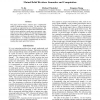Free Online Productivity Tools
i2Speak
i2Symbol
i2OCR
iTex2Img
iWeb2Print
iWeb2Shot
i2Type
iPdf2Split
iPdf2Merge
i2Bopomofo
i2Arabic
i2Style
i2Image
i2PDF
iLatex2Rtf
Sci2ools
AAAI
2007
2007
Mutual Belief Revision: Semantics and Computation
This paper presents both a semantic and a computational model for multi-agent belief revision. We show that these two models are equivalent but serve different purposes. The semantic model displays the intuition and construction of the belief revision operation in multi-agent environments, especially in case of just two agents. The logical properties of this model provide strong justifications for it. The computational model enables us to reassess the operation from a computational perspective. A complexity analysis reveals that belief revision between two agents is computationally no more demanding than single agent belief revision.
AAAI 2007 | Belief Revision | Computational Model | Intelligent Agents | Multi-agent Belief Revision |
| Added | 02 Oct 2010 |
| Updated | 02 Oct 2010 |
| Type | Conference |
| Year | 2007 |
| Where | AAAI |
| Authors | Yi Jin, Michael Thielscher, Dongmo Zhang |
Comments (0)

